Investigation into Pressure Appearances and Hydraulic Fracturing Roof-Cutting Technology in Mining Working Face under Residual Pillars: A Case Study
Abstract
:1. Introduction
2. Engineering Background
2.1. Geological Conditions
2.2. Mining Pressure Characteristics
3. Physical Simulation of Pressure Appearances in MWFRPs
3.1. Physical Model Design
3.2. Overlying Strata Fracture Characteristics
3.3. Evolution Characteristics of Mining Stress
3.4. Displacement of Overlying Strata
4. Numerical Simulation of the Influence of Rupture Length of THS II
4.1. Model Construction
4.2. Failure Characteristics of THS I
5. Hydraulic Roof-Cutting Control Technology
5.1. Hydraulic Roof Cutting Scheme
5.2. Hydraulic Roof-Cutting Control Effect
5.2.1. Hydraulic Fracturing Water Pressure
5.2.2. Borehole Camera Exploration for Hydraulic Fractures
5.2.3. Working Resistance of Hydraulic Support
6. Discussion
7. Conclusions
- (1)
- For MWFRPs, the distribution of hydraulic support resistance within the range of 40–45 MPa increases to 66.7%, and the safety valve opening rate increases to 31.2% (the safety valve opening pressure is 43 MPa). Therefore, the appearance of strong mining pressures in MWFRPs can easily cause hydraulic support-crushing accidents.
- (2)
- During the mining period of MWFRPs, the instability of overlying residual pillars caused the upper thick hard strata (THS II) to rupture and form a “T-shaped structure”. The rotation and sinking deformation of the structure lead to the dynamic load being transmitted downwards, leading to the shear failure in lower thick strata (THS I) along the boundary of the residual pillar. This led to a 70.4% increase in mining pressure in the working face, resulting in the appearance of strong mining pressures.
- (3)
- The numerical simulation shows that the shear damage of THS I corresponding to a fracture length of 50 m, 40 m, and 30 m in THS II was 37, 29.43, and 23.59%, respectively. During the mining period of MWFRPs, the smaller the length of the THS II fracture block, the smaller the shear damage of THS I, and the lower the mining pressure in the working face.
- (4)
- A hydraulic fracturing roof-cutting pressure-relief technology was proposed to destroy the integrity of THS I and THS I in MWFRPs. The field applications show that THS II ruptured above the residual pillar. All the support pressures were less than 40 MPa, which means that the strong dynamic load borne by the hydraulic support was reduced, proving the effectiveness of the hydraulic roof-cutting control technology.
Author Contributions
Funding
Acknowledgments
Conflicts of Interest
Correction Statement
References
- Zhang, Y.Q.; Wang, X.Y.; Zhang, F.T.; Li, M.L.; Wang, G.H.; Chen, D.C.; Li, G.J.; Zhao, X.Q. Retracement ground pressure appearance and control of the working face under the overlying residual pillar: A case study. Energies 2023, 16, 1701. [Google Scholar] [CrossRef]
- Zhu, D.F.; Tu, S.H.; Tu, H.S.; Yang, Z.Q. Mechanisms of support failure and prevention measures under double-layer room mining gobs—A case study: Shigetai coal mine. Int. J. Min. Sci. Technol. 2019, 29, 955–962. [Google Scholar] [CrossRef]
- Liu, H.F.; Sun, Q.; Zhou, N.; Wu, Z.Y. Risk Assessment and control strategy of residual coal pillar in room mining: Case study in ecologically fragile mining areas, China. Sustainability 2021, 13, 2712. [Google Scholar] [CrossRef]
- Ju, J.F.; Xu, J.L.; Zhu, W.B.; Liu, K. Influence of cut-hole position on support crushing during mining out coal pillar at the side of upper goaf in close distance of shallow seams. Chin. J. Rock Mech. Eng. 2014, 33, 2018–2029. [Google Scholar]
- Wu, W.D.; Bai, J.B.; Wang, X.Y.; Zhu, Z.J.; Yan, S. Field investigation of fractures evolution in overlying strata caused by extraction of the jurassic and carboniferous coal seams and its application: Case study. Int. J. Coal Geol. 2019, 208, 12–23. [Google Scholar] [CrossRef]
- Bai, J.W.; Song, C.; Wang, H.W.; Qi, T.Y.; Feng, G.R.; Cao, G.M.; Wang, K.; Guo, J.; Shi, X.D.; Cui, B.Q. Identification method and software of key pillar in the residual pillar system. J. China Coal Soc. 2022, 47, 651–661. [Google Scholar]
- Liang, Y.P.; Li, B.; Zou, Q.L. Movement type of the first subordinate key stratum and its influence on strata behavior in the fully mechanized face with large mining height. Arab. J. Geosci. 2019, 12, 12–31. [Google Scholar] [CrossRef]
- Bosikov, I.I.; Martyushev, N.V.; Klyuev, R.V.; Savchenko, I.A.; Kukartsev, V.V.; Kukartsev, V.A.; Tynchenko, Y.A. Modeling and complex analysis of the topology parameters of ventilation networks when ensuring fire safety while developing coal and gas deposits. Fire 2023, 6, 95. [Google Scholar] [CrossRef]
- Balovtsev, S.V.; Skopintseva, O.V.; Kolikov, K.S. Aerological risk management in preparation for mining of coal mines. Sustain. Dev. Mt. Territ. 2022, 14, 107–116. [Google Scholar] [CrossRef]
- Zhu, W.B.; Xu, J.M.; Li, Y.C. Mechanism of the dynamic pressure caused by the instability of upper chamber coal pillars in Shendong coalfield, China. Geosci. J. 2017, 21, 1–13. [Google Scholar] [CrossRef]
- Xu, J.M.; Zhu, W.B.; Ju, J.F. Mechanism of dynamic mine pressure occurring below adjacent upper chamber mining goaf with shallow cover depth. J. China Coal Soc. 2017, 42, 500–509. [Google Scholar]
- Zhu, W.B.; Chen, L.; Zhou, Z.L.; Shen, B.T.; Xu, Y. Failure propagation of pillars and roof in a room and pillar mine induced by longwall mining in the lower seam. Rock Mech. Rock Eng. 2019, 52, 1193–1209. [Google Scholar] [CrossRef]
- Wang, F.T.; Zhang, C. Reasonable coal pillar design and remote control mining technology for highwall residual coal resources. Roy. Soc. Open Sci. 2019, 6, 181817. [Google Scholar] [CrossRef] [PubMed] [Green Version]
- Guo, F.; Gao, B.; Niu, G.Q.; Wang, Z.G. Study on mine strata pressure law of fully mechanized coal mining face under coal pillars and goaf in contiguous seams. Coal Sci. Technol. 2017, 45, 92–97. [Google Scholar]
- Zhou, K.Y.; Zhang, H.W.; Li, Y.P.; Fu, X.; Cao, Y. Study on the zoning characteristics of strata behaviors during the primary mining of mining face under contiguous goaf. Coal Sci. Technol. 2018, 46, 54–60. [Google Scholar]
- Huo, B.J.; Jing, X.D.; Fan, Z.L.; Xie, W.; Duan, Z.H.; Xie, Z.H. Mechanism of dynamic load of longwall mining under shallow room mining goaf. China J. Geo. Eng. 2019, 41, 1116–1123. [Google Scholar]
- Tian, C.L.; Yang, X.L.; Sun, H.T.; Liu, Y.B.; Hu, Q.T. Experimental study on the overburden movement and stress evolution in multi-seam mining with residual pillars. Energy Sci. Eng. 2019, 7, 3095–3110. [Google Scholar] [CrossRef] [Green Version]
- Fu, X.Y.; Li, H.Y.; Li, F.M.; Li, S.G.; Zhang, B.; Li, H.J.; Wei, L.K. Mechanism and prevention of strong strata behaviors induced by the concentration coal pillar of a room mining goaf. J. China Coal Soc. 2016, 41, 1375–1383. [Google Scholar]
- Poulsen, B.A. Coal pillar load calculation by pressure arch theory and near field extraction ratio. Int. J. Rock Mech. Min. Sci. 2010, 47, 1158–1165. [Google Scholar] [CrossRef]
- Zhang, C.; Zhao, Y.X.; Han, P.H.; Bai, Q.S. Coal pillar failure analysis and instability evaluation methods: A short review and prospect. Eng. Fail. Anal. 2022, 138, 106344. [Google Scholar] [CrossRef]
- Wu, W.D.; Bai, J.B.; Wang, X.Y.; Yan, S.; Wu, S.X. Numerical study of failure mechanisms and control techniques for a gob-side yield pillar in the Sijiazhuang coal mine, China. Rock Mech. Rock Eng. 2019, 52, 1231–1245. [Google Scholar] [CrossRef]
- Esterhuizen, G.S.; Tyrna, P.L.; Murphy, M.M. A case study of the collapse of slender pillars affected by through-going discontinuities at a limestone mine in Pennsylvania. Rock Mech. Rock Eng. 2019, 52, 4941–4952. [Google Scholar] [CrossRef] [PubMed]
- Tian, Y.; Gong, P.L.; Zhao, T.; Yi, K.; Wen, G. Instability prediction model of remaining coal pillars under remining disturbance. Energy Sci. Eng. 2023, 1–16. [Google Scholar] [CrossRef]
- Hashiba, K.; Fukui, K. Time—Dependent behaviors of granite: Loading-rate dependence, creep, and relaxation. Rock Mech. Rock Eng. 2016, 49, 2569–2580. [Google Scholar] [CrossRef]
- Zhou, Z.L.; Chen, L.; Cai, X.; Shen, B.T.; Zhou, J.; Du, K. Experimental investigation of the progressive failure of multiple pillar-roof system. Rock Mech. Rock Eng. 2018, 51, 1629–1636. [Google Scholar] [CrossRef]
- Zhou, Z.L.; Zang, H.Z.; Cao, W.Z.; Du, X.M.; Chen, L.; Ke, C.T. Risk assessment for the cascading failure of underground pillar sections considering interaction between pillars. Int. J. Rock Mech. Min. Sci. 2019, 124, 104142. [Google Scholar] [CrossRef]
- Dong, H.Y.; Zhu, W.C.; Hou, C.; Liu, X.G. Load transfer behavior during cascading pillar failure: An experimental study. Rock Mech. Rock Eng. 2022, 55, 1445–1460. [Google Scholar] [CrossRef]
- Meng, N.K.; Chen, Y.; Bai, J.B.; Wang, X.Y.; Wu, W.D.; Wu, B.W. Numerical simulation of directional fracturing by shaped charge blasting. Energy Sci. Eng. 2020, 8, 1824–1839. [Google Scholar] [CrossRef]
- Zhou, N.; Yan, H.; Jiang, S.Y.; Sun, Q.; Ouyang, S.Y. Stability Analysis of Surrounding Rock in Paste Backfill Recovery of Residual Room Pillars. Sustainability 2019, 11, 478. [Google Scholar] [CrossRef] [Green Version]
- Miao, K.J.; Wang, D.P.; Tu, S.H.; Tu, H.S.; Zhu, D.F.; Liu, X.W.; Li, W.L.; Tang, L. The principle and practice of strong mine pressure control in the initial mining and caving stages under multiple key strata. Sustainability 2022, 14, 5772. [Google Scholar] [CrossRef]
- Li, Y.; Yang, T.H.; Hao, N.; Song, W.D.; Fu, J.X.; Yu, L. Mining rate effect of high-intensity working face based on stress release rate and microseismic monitoring. J. Min. Saf. Eng. 2022, 38, 295–303. [Google Scholar]
- Dehghan, A.N. An experimental investigation into the influence of pre-existing natural fracture on the behavior and length of propagating hydraulic fracture. Eng. Fract. Mech. 2020, 24, 107330. [Google Scholar] [CrossRef]
- Huang, B.X.; Wang, Y.Z.; Cao, S.G. Cavability control by hydraulic fracturing for top coal caving in hard thick coal seams. Int. J. Rock Mech. Min. Sci. 2015, 74, 45–57. [Google Scholar] [CrossRef]
- Chang, Q.L.; Yao, X.J.; Wang, X.Y.; Yang, S.; Sun, Y.T. Investigation on hydraulic fracturing and cutting roof Pressure relief technology for underground mines: A case study. Lithosphere 2021, 2021, 4277645. [Google Scholar] [CrossRef]
- Jeffrey, R.G.; Mills, K.W. Hydraulic fracturing applied to inducing longwall coal mine goaf falls. In Proceedings of the 4th North American Rock Mechanics Symposium, Seattle, WA, USA, 31 July–3 August 2000; pp. 423–430. [Google Scholar]
- Klishin, V.; Opruk, G.; Ponizov, A. Directional hydraulic fracturing application for reduction of rock heaving intensity in the development opening under conditions of S.M. Kirov Mine. In Proceedings of the Russian-Chinese Symposium on Coal in the 21st century, Qingdao, China, 18–21 October 2018. [Google Scholar]
- Jendry, M.; Hadam, A.; Wikaa, M. Directional hydraulic fracturing (DHF) of the roof, as an element of rock burst prevention in the light of underground observations and numerical modelling. Energies 2021, 14, 562. [Google Scholar] [CrossRef]
- He, Q.Y.; Suorineni, F.T.; Oh, J. Strategies for creating prescribed hydraulic fractures in cave mining. Rock Mech. Rock Eng. 2017, 50, 967–993. [Google Scholar] [CrossRef]
- Zhang, F.T.; Wang, X.Y.; Bai, J.B.; Wu, W.D.; Wu, B.W.; Wang, G.H. Fixed-length roof cutting with vertical hydraulic fracture based on the stress shadow effect: A case study. Int. J. Min. Sci. Technol. 2022, 32, 295–308. [Google Scholar] [CrossRef]
- Liu, W.J.; Yang, K.; He, X.; Zhang, Z.N.; Xu, R.J. Mechanism and control technology of rockburst induced by thick hard roof and residual coal pillar: A case study. Geofluids 2023, 2023, 3523592. [Google Scholar] [CrossRef]
- Gao, R.; Kuang, T.J.; Zhang, Y.Q.; Zhang, W.Y.; Quan, C.Y. Controlling mine pressure by subjecting high-level hard rock strata to ground fracturing. Int. J. Coal Sci. Technol. 2021, 8, 1336–1350. [Google Scholar] [CrossRef]
- Yang, S.; Li, X.H.; Wang, J.; Yang, S.H.; Shen, Z.; Xu, G.Z. Study on pressure relief technology of high-pressure water jet of residual coal pillar in overlying goaf in close seam mining. Shock Vib. 2022, 2022, 7842921. [Google Scholar] [CrossRef]
- Kang, H.P.; Si, L.P.; Zhang, X. Characteristics of underground in-situ stress distribution in shallow coal mines and its applications. J. China Coal Soc. 2016, 41, 1332–1340. [Google Scholar]
- Gao, F.Q. Simulation of Failure Mechanisms around Underground Coal Mine Openings Using Discrete Element Modelling. Ph.D. Thesis, Simon Fraster University, Burnaby, BC, Canada, 2013. [Google Scholar]
- Coonrod, C.L.; Yin, Y.B.; Hanna, T.; Atkinson, A.J.; Wong, M.S. Fit-for-purpose treatment goals for produced waters in shale oil and gas fields. Water Res. 2020, 173, 115467. [Google Scholar] [CrossRef] [PubMed]
- Lekontsev, Y.M.; Sazhin, P.V.; Ushakov, S.Y. Interval hydraulic fracturing to weaken dirt bands in coal. J. Min. Sci. 2013, 48, 525–532. [Google Scholar] [CrossRef]
- Lekontsev, Y.M.; Sazhin, P.V. Directional hydraulic fracturing in difficult caving roof control and coal degassing. J. Min. Sci. 2014, 50, 525–532. [Google Scholar] [CrossRef]
- Subrahmanyam, D.S.; Shyam, G.; Vamshidhar, K.; Vikram, S. State-of-the-art technique to conduct in situ stress measurements in deep proposed coal-mining blocks of Singareni collieries, India. Curr. Sci. India 2020, 119, 1027–1030. [Google Scholar] [CrossRef]
- Cheng, Q.Y.; Huang, B.X.; Shao, L.Y.; Chen, S.L.; Li, H.Z.; Wang, C.W. Combination of pre-pulse and constant pumping rate hydraulic fracturing for weakening hard coal and rock mass. Energies 2020, 13, 5534. [Google Scholar] [CrossRef]
- Mahdavian, D.; Javadi, A. Study of hydraulic fracturing for gas drainage in a coal mine in Iran. Environ. Geotech. 2022, 8, 547–558. [Google Scholar] [CrossRef]
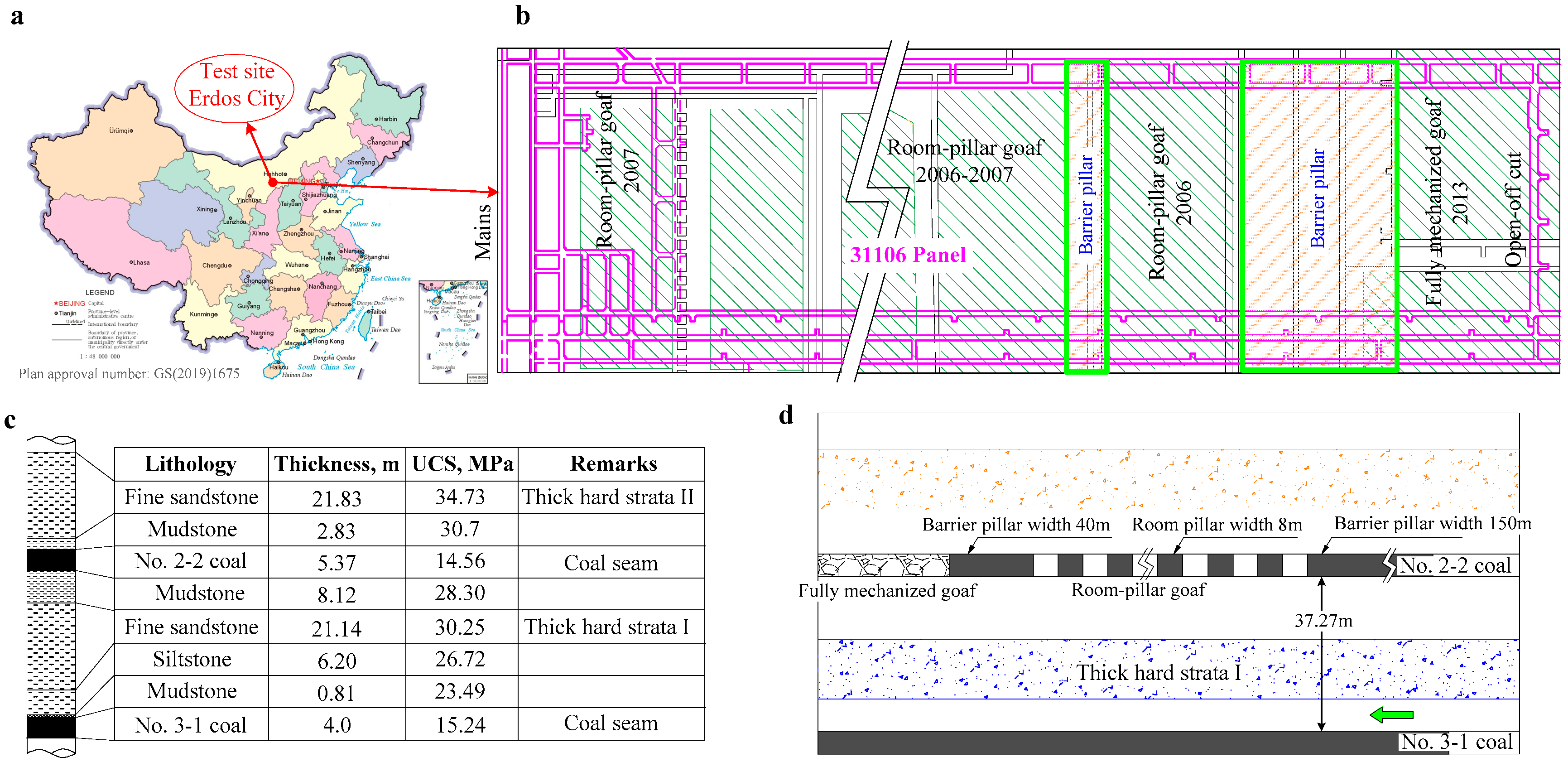
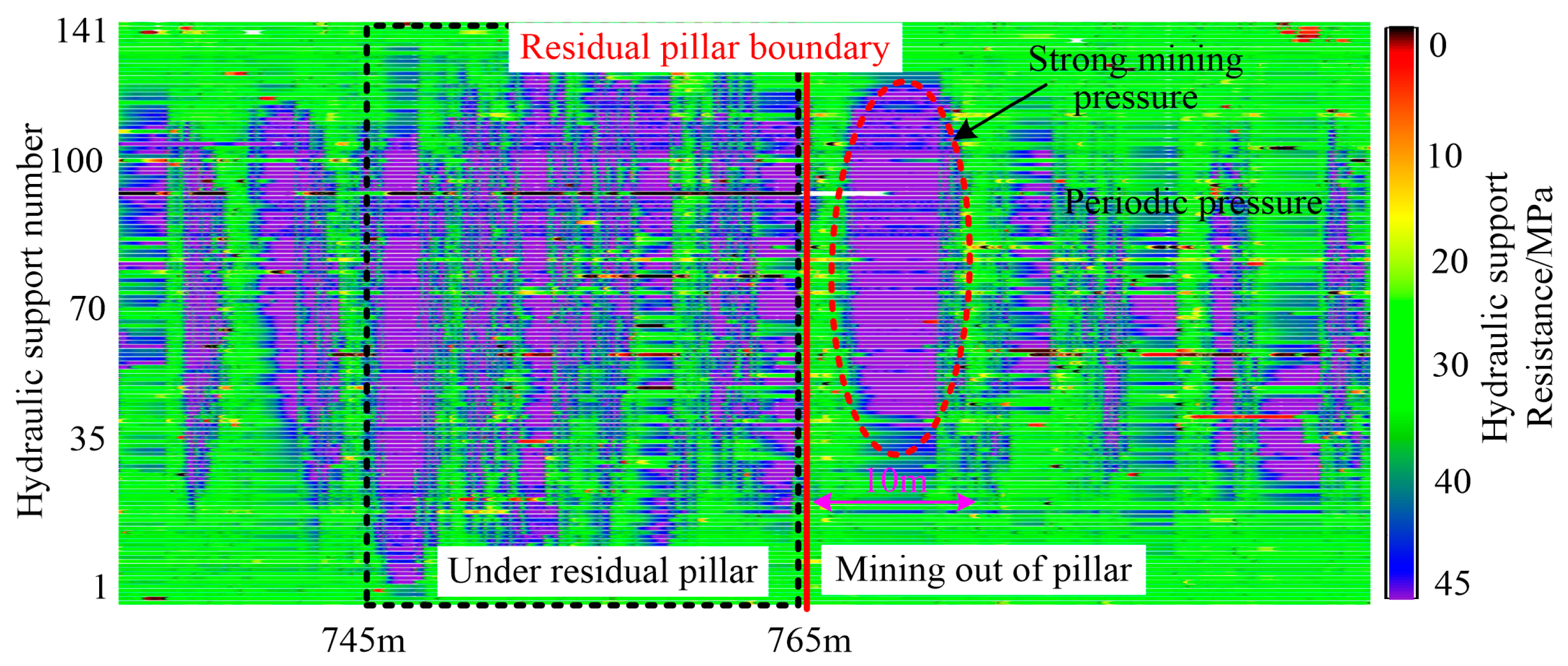
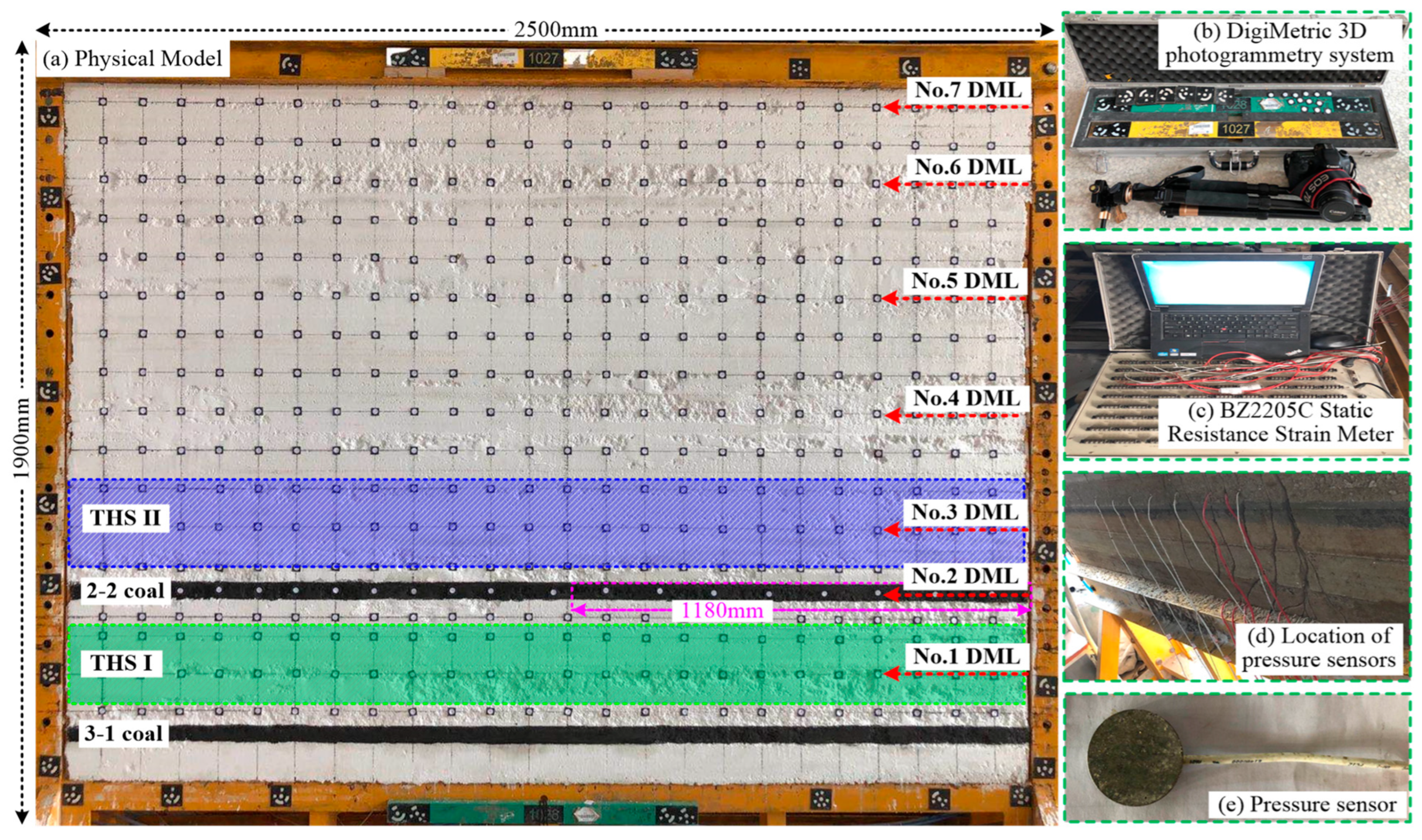

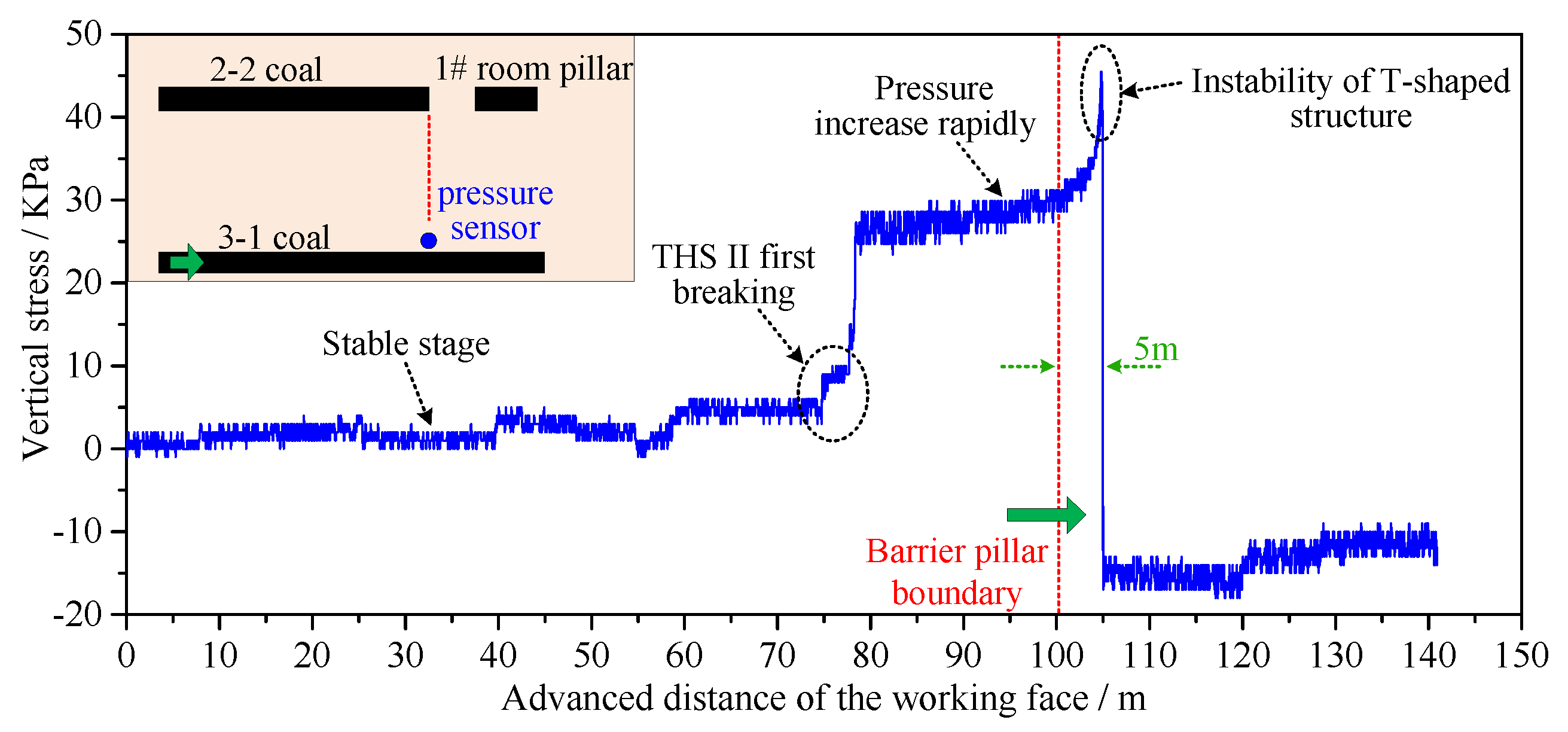
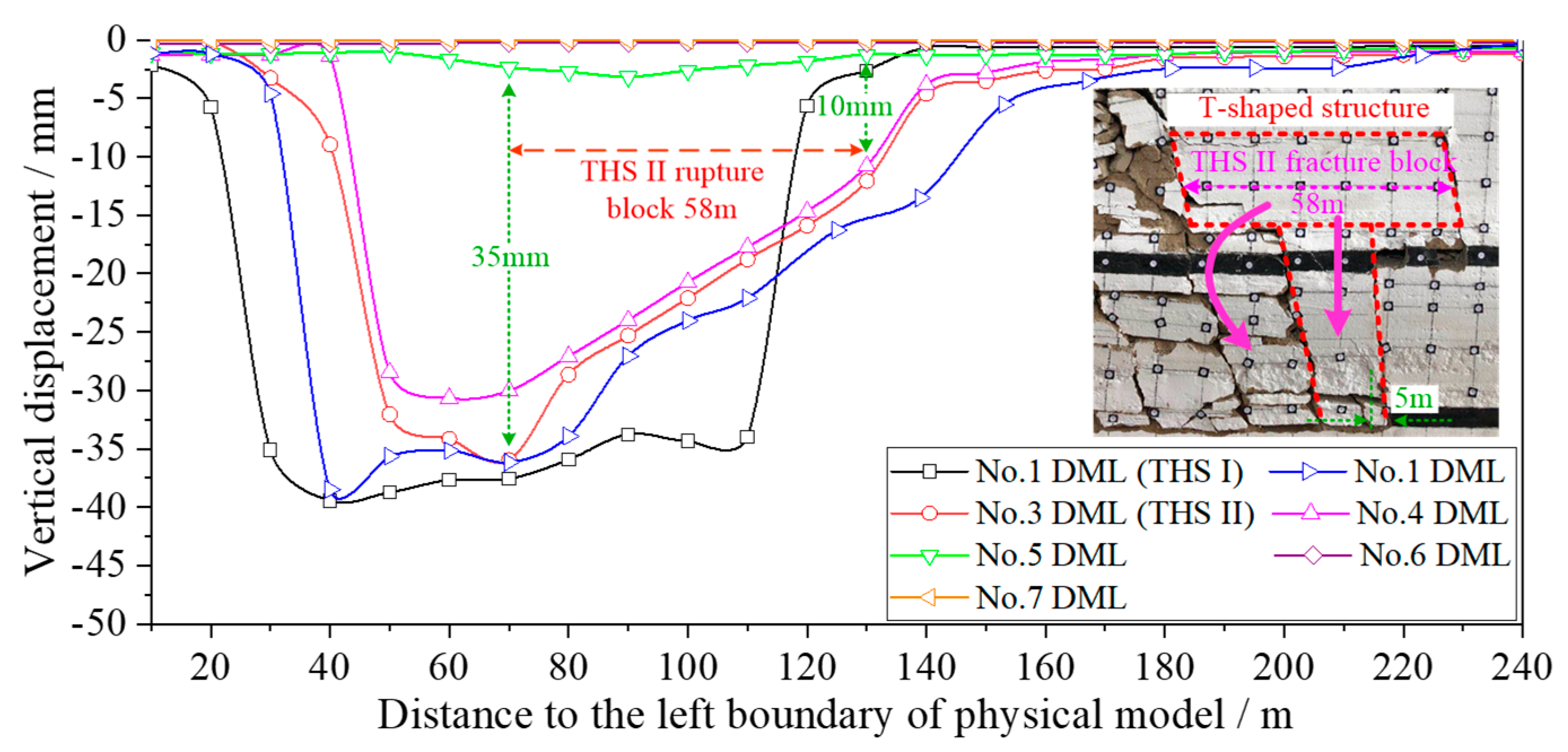
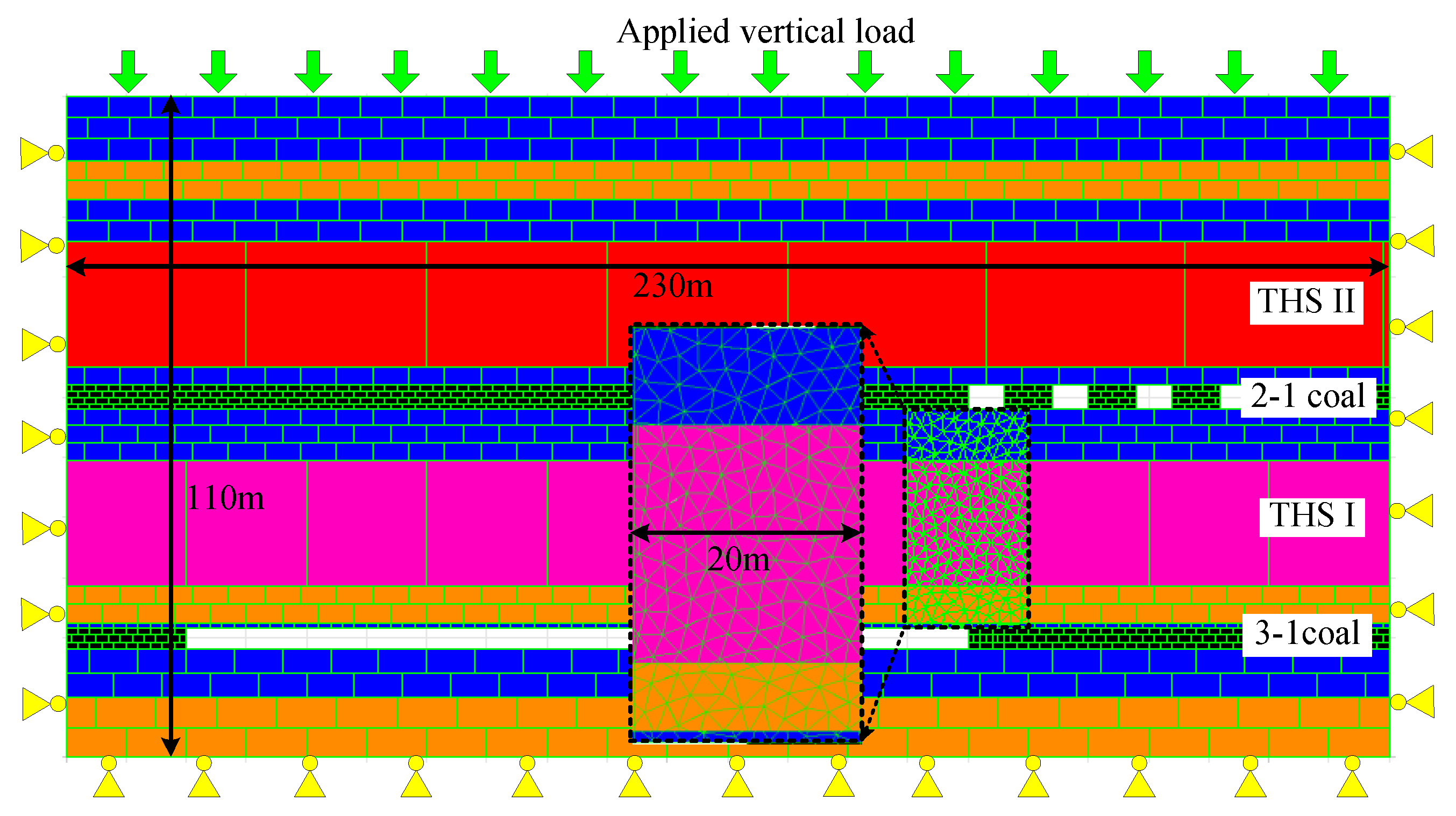

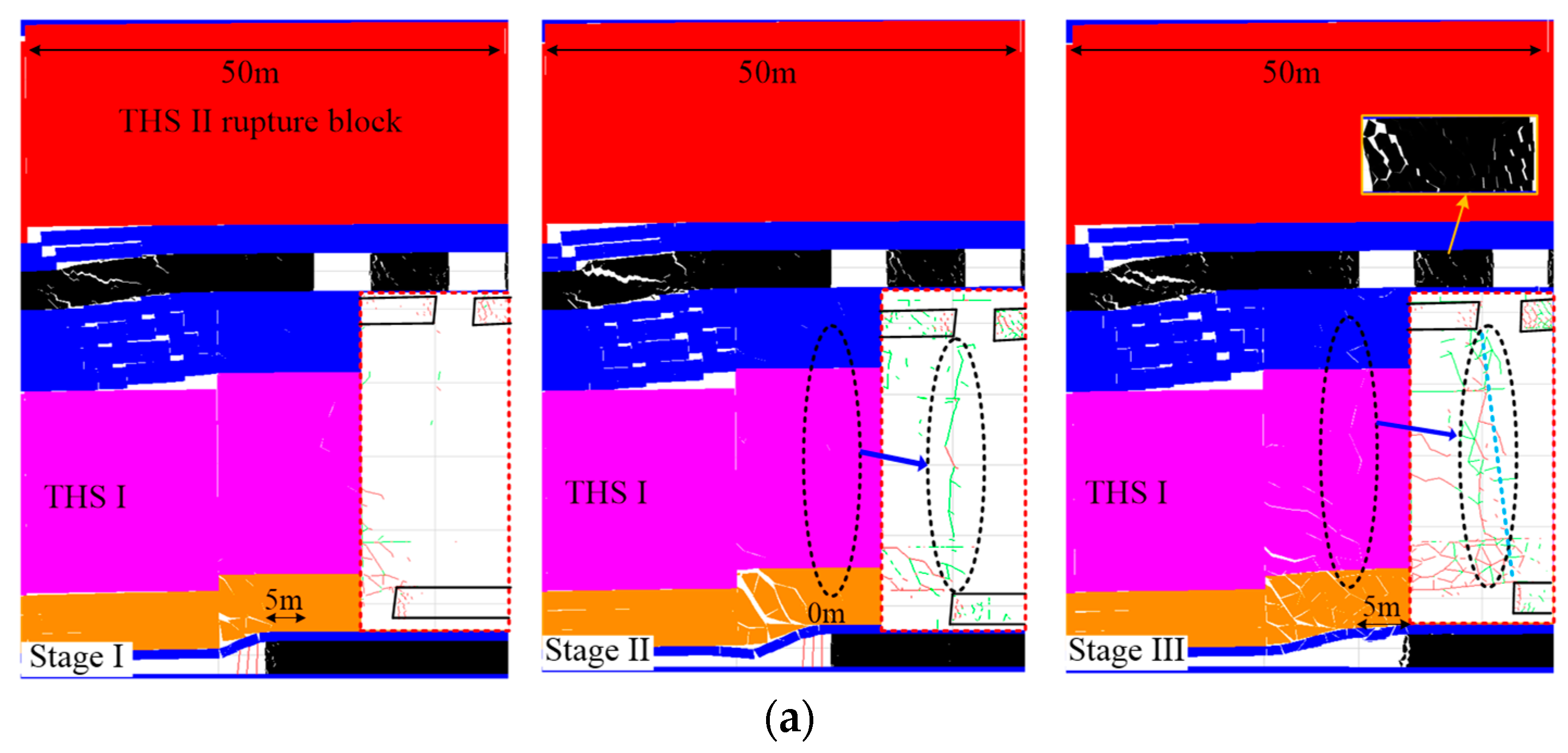
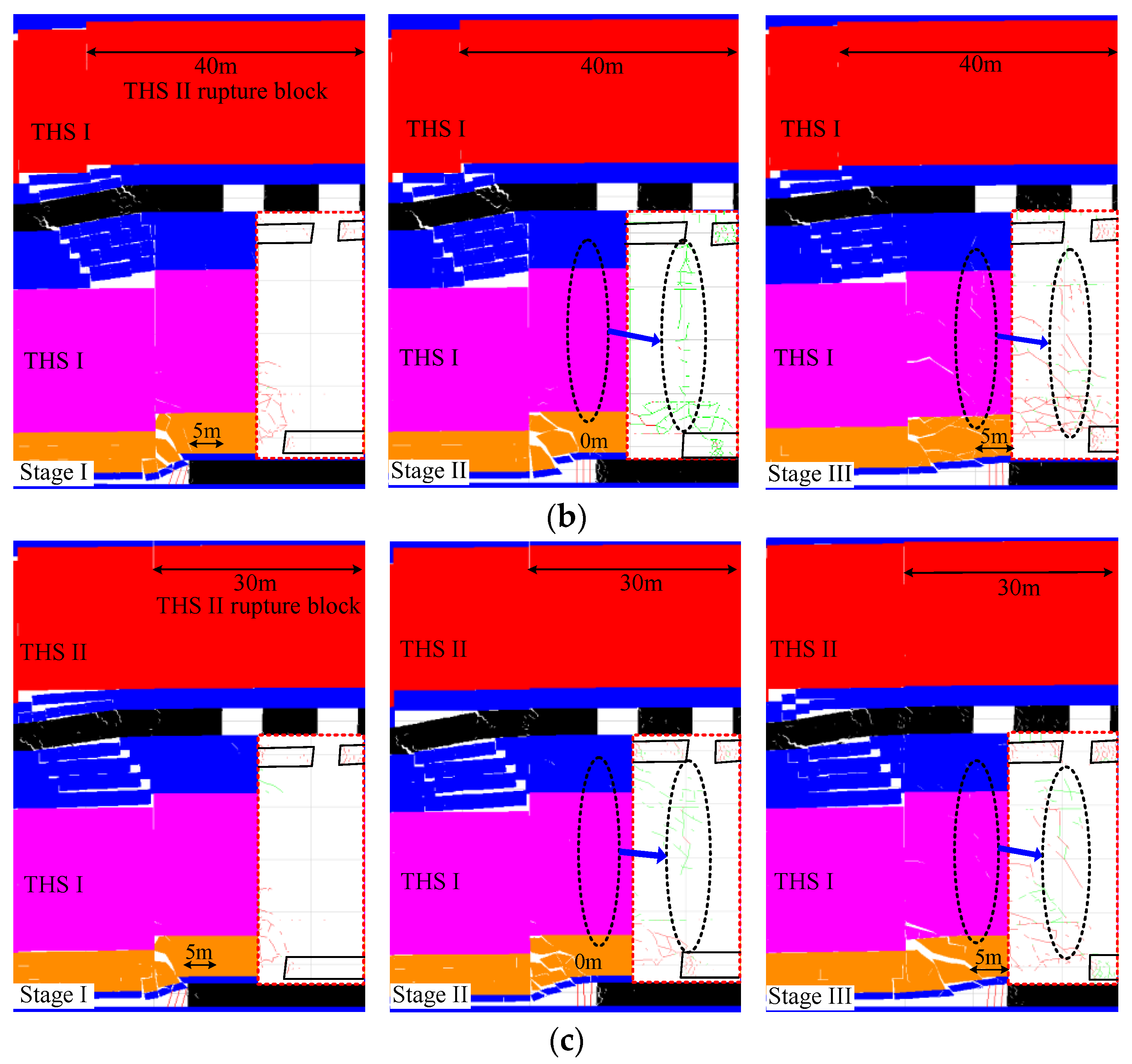

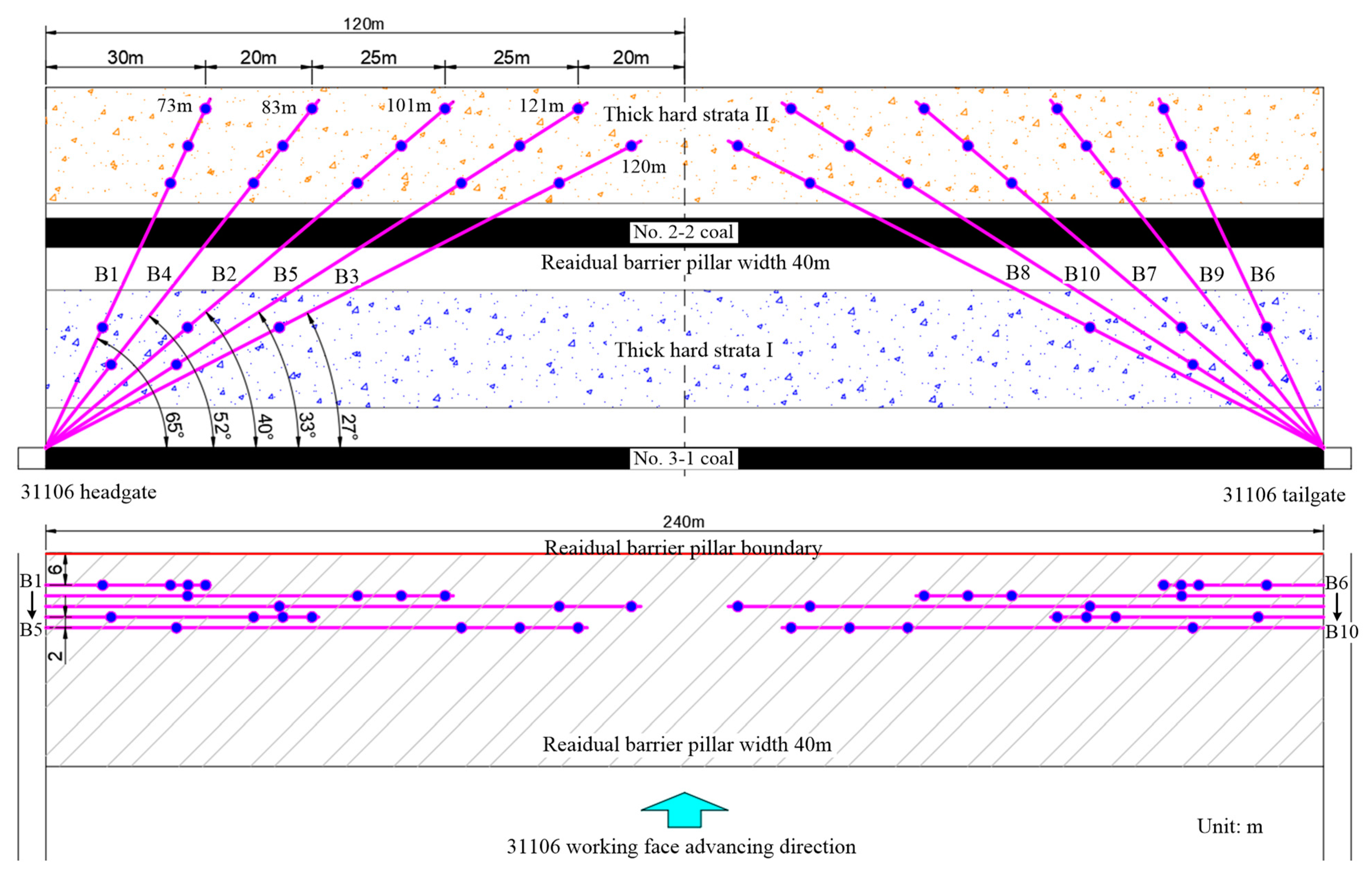


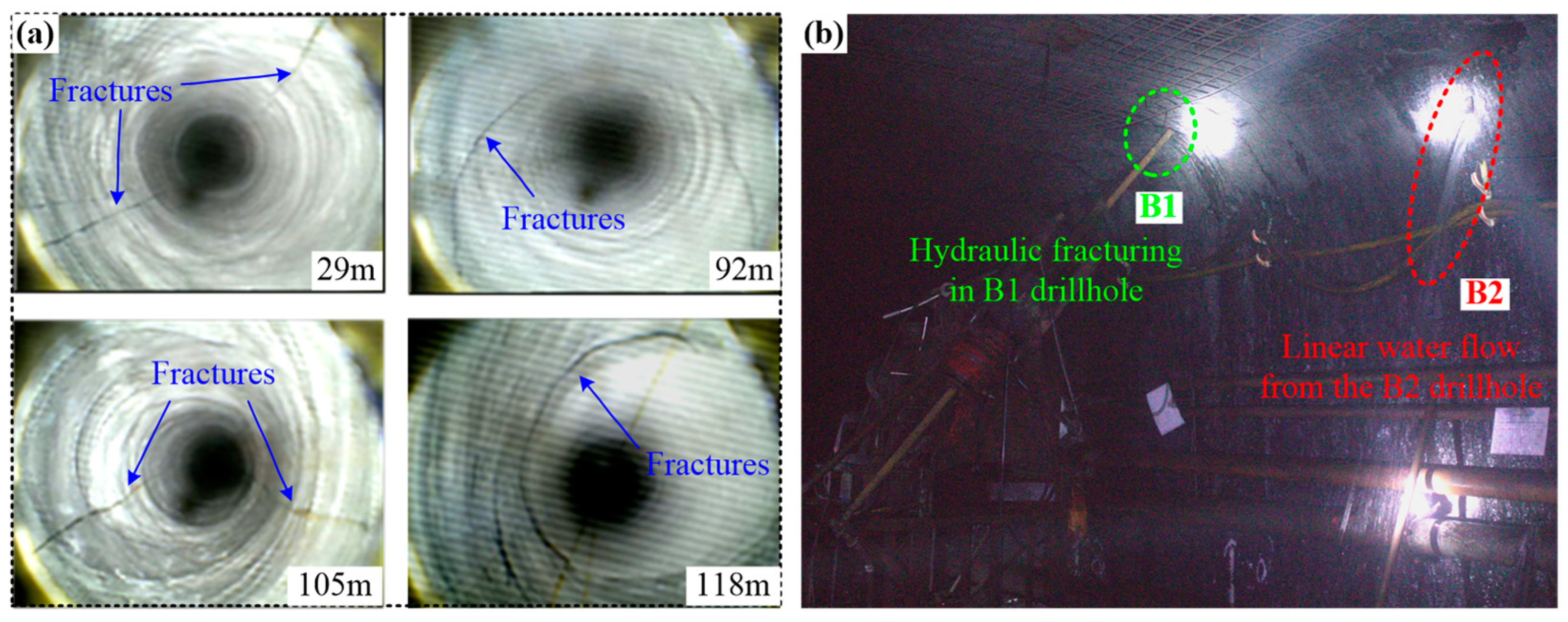

| Bed No. | Lithology | Thickness (cm) | Matching Number | Gross Weight (kg) | Sand (kg) | CaCO3 (kg) | Gypsum (kg) | Water (L) |
|---|---|---|---|---|---|---|---|---|
| 22 | Loess layer | 8 | 773 | 74.80 | 65.45 | 6.55 | 2.81 | 8.31 |
| 21 | Medium-grained sandstone | 5 | 373 | 46.75 | 35.06 | 8.18 | 3.51 | 5.19 |
| 20 | Siltstone | 11 | 455 | 102.85 | 82.28 | 10.29 | 10.29 | 11.43 |
| 19 | Sandy mudstone | 12 | 637 | 112.20 | 96.17 | 4.81 | 11.22 | 12.47 |
| 18 | Medium-grained sandstone | 14 | 373 | 130.90 | 98.18 | 22.91 | 9.82 | 14.54 |
| 17 | Sandy mudstone | 6 | 637 | 56.10 | 48.09 | 2.40 | 5.61 | 6.23 |
| 16 | Medium-grained sandstone | 12 | 373 | 112.20 | 84.15 | 19.64 | 8.42 | 12.47 |
| 15 | Fine sandstone | 12 | 355 | 112.20 | 84.15 | 14.03 | 14.03 | 12.47 |
| 14 | Medium-grained sandstone | 7 | 373 | 65.45 | 49.09 | 11.45 | 4.91 | 7.27 |
| 13 | Sandy mudstone | 5 | 637 | 46.75 | 40.07 | 2.00 | 4.68 | 5.19 |
| 12 | Fine sandstone | 11 | 355 | 102.85 | 77.14 | 12.86 | 12.86 | 11.43 |
| 11 | Medium-grained sandstone | 3 | 373 | 28.05 | 21.04 | 4.91 | 2.10 | 3.12 |
| 10 | Siltstone | 4 | 455 | 37.40 | 29.92 | 3.74 | 3.74 | 4.16 |
| 9 | Fine sandstone | 22 | 437 | 205.70 | 164.56 | 12.34 | 28.80 | 22.86 |
| 8 | Mudstone | 3 | 555 | 28.05 | 23.38 | 2.34 | 2.34 | 3.12 |
| 7 | No. 2-2 coal | 5 | 573 | 46.75 | 38.96 | 5.45 | 2.34 | 5.19 |
| 6 | Mudstone | 8 | 555 | 74.80 | 62.33 | 6.23 | 6.23 | 8.31 |
| 5 | Fine sandstone | 21 | 355 | 196.35 | 147.26 | 24.54 | 24.54 | 21.82 |
| 4 | Siltstone | 6 | 455 | 56.10 | 44.88 | 5.61 | 5.61 | 6.23 |
| 3 | Mudstone | 1 | 555 | 9.35 | 7.79 | 0.78 | 0.78 | 1.04 |
| 2 | No. 3-1 coal | 4 | 573 | 37.40 | 31.17 | 4.36 | 1.87 | 4.16 |
| 1 | Sandy mudstone | 10 | 637 | 93.50 | 80.14 | 4.01 | 9.35 | 10.39 |
| Rock Strata | Block Properties | Joint Properties | ||||||
|---|---|---|---|---|---|---|---|---|
| Density (kg/m3) | E (GPa) | Poisson’s Ratio | Kn (GPa/m) | Ks (GPa/m) | Cohesion (MPa) | Friction Angle (°) | Tensile Strength (MPa) | |
| THS II | 2358 | 2.88 | 0.29 | 37.73 | 15.09 | 4.65 | 32 | 4.00 |
| THS I | 2281 | 2.13 | 0.25 | 25.60 | 10.24 | 3.82 | 29 | 3.59 |
| Siltstone | 2267 | 1.60 | 0.26 | 19.62 | 7.85 | 3.31 | 23 | 3.27 |
| Sandy mudstone | 2182 | 0.95 | 0.28 | 12.12 | 4.85 | 2.49 | 20 | 2.79 |
| Coal seam | 1263 | 0.31 | 0.26 | 11.51 | 4.59 | 1.55 | 17 | 1.92 |
| No. | Technology | Coal Mine | Purpose | Region | Reference |
|---|---|---|---|---|---|
| 1 | Hydraulic fracturing | Moonee Colliery | Inducing a goaf event and controlling the timing of caving events | Australia | [35] |
| 2 | Singareni collieries | In-situ stress measurement | India | [48] | |
| 4 | Bailu Coal Mine | Weakening hard coal and rock mass | China | [49] | |
| Parvadeh 4 coal mine | Gas drainage | Iran | [50] | ||
| 5 | Yanzishan coal mine | Weakening and relieving stress | China | [42] | |
| 6 | Shale oil and gas fields | Stimulating the release of entrapped hydrocarbons from formations | USA | [45] | |
| 7 | gas fields | Roof Pressure | China | [34] | |
| 8 | Directional hydraulic fracturing | S.M. Kirov Mine | Reducing rock-heaving intensity in the development opening | Russian | [36] |
| 9 | Romanovsky Mine | Weakening a dirt band in Abramovsky coal seam | Russian | [46] | |
| 10 | Kuzbass Coal Mine | Caving roof control in production faces and coal bed degassing | Russian | [47] | |
| 11 | “Rydultowy” Black Coal Mine | Rock burst prevention | Poland | [37] | |
| 12 | Boertai Coal Mine | Block caving and rock burst prevention | China | [40] |
Disclaimer/Publisher’s Note: The statements, opinions and data contained in all publications are solely those of the individual author(s) and contributor(s) and not of MDPI and/or the editor(s). MDPI and/or the editor(s) disclaim responsibility for any injury to people or property resulting from any ideas, methods, instructions or products referred to in the content. |
© 2023 by the authors. Licensee MDPI, Basel, Switzerland. This article is an open access article distributed under the terms and conditions of the Creative Commons Attribution (CC BY) license (https://creativecommons.org/licenses/by/4.0/).
Share and Cite
Wu, W.; Feng, G.; Yu, X.; Bai, J.; Wang, X.; Zhao, X. Investigation into Pressure Appearances and Hydraulic Fracturing Roof-Cutting Technology in Mining Working Face under Residual Pillars: A Case Study. Energies 2023, 16, 3914. https://doi.org/10.3390/en16093914
Wu W, Feng G, Yu X, Bai J, Wang X, Zhao X. Investigation into Pressure Appearances and Hydraulic Fracturing Roof-Cutting Technology in Mining Working Face under Residual Pillars: A Case Study. Energies. 2023; 16(9):3914. https://doi.org/10.3390/en16093914
Chicago/Turabian StyleWu, Wenda, Guorui Feng, Xiuxiu Yu, Jianbiao Bai, Xiangyu Wang, and Xiangzhuo Zhao. 2023. "Investigation into Pressure Appearances and Hydraulic Fracturing Roof-Cutting Technology in Mining Working Face under Residual Pillars: A Case Study" Energies 16, no. 9: 3914. https://doi.org/10.3390/en16093914





